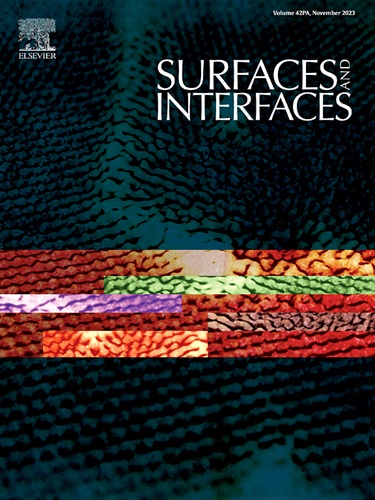Solution-processed gallium oxide semiconductor nanomaterials via surface chemical activity of liquid metals
IF 5.7
2区 材料科学
Q2 CHEMISTRY, PHYSICAL
引用次数: 0
Abstract
The fourth-generation semiconductor material, gallium oxide (Ga2O3) has received extensive attention for its wide bandgap, ultra-high breakdown electric field, high temperature resistance, and better radiation resistance. Ga2O3 nanomaterials are primarily synthesized through the thermal treatment of gallium oxyhydroxide (GaOOH), but the synthesis methods of GaOOH depend on complex reaction process, high temperature and high pressure, precision equipment and other reaction conditions, resulting the applicability is significantly limited. Herein, a straightforward, flexible, environmentally friendliness, and maneuverable method for synthesizing GaOOH is presented. Under ambient conditions, when liquid metals (LMs) were immersed in deionized water (DI water), the Ga atoms on their surface can capture the oxygen atoms and oxygen-containing groups at lower energies, thereby transforming into nano-GaOOH. Moreover, LMs exhibit high surface tension and fluidity, which facilitates the easy detachment of GaOOH nanomaterials from their surface under mechanical agitation. Simultaneously, the triboelectrification between LMs and polytetrafluoroethylene (PTFE) facilitates the reaction. Furthermore, the GaOOH nanomaterials were annealed into Ga2O3 nanomaterials. This strategy is grounded in the principles of sustainability and efficiency, which can be implemented on a large scale. This approach plays a crucial role in advancing modern semiconductor technology and holds significant practical implications as well as promising development prospects.

液相金属表面化学活性的溶液法制备氧化镓半导体纳米材料
作为第四代半导体材料,氧化镓(Ga2O3)以其宽带隙、超高击穿电场、耐高温和较好的耐辐射性而受到广泛关注。Ga2O3纳米材料的合成主要是通过对羟基氧化镓(GaOOH)进行热处理,但GaOOH的合成方法依赖于复杂的反应过程、高温高压、精密的设备等反应条件,导致其适用性明显受到限制。本文提出了一种简单、灵活、环保、可操作的合成高ooh的方法。在环境条件下,液态金属(LMs)浸泡在去离子水(DI水)中,其表面的Ga原子可以以较低的能量捕获氧原子和含氧基团,从而转化为纳米gaooh。此外,LMs具有较高的表面张力和流动性,这使得高ooh纳米材料在机械搅拌下容易从表面脱离。同时,LMs与聚四氟乙烯(PTFE)之间的摩擦起电作用促进了反应。进一步,将GaOOH纳米材料退火成Ga2O3纳米材料。这一战略以可持续性和效率原则为基础,可以大规模实施。这种方法对推进现代半导体技术的发展起着至关重要的作用,具有重要的实际意义和良好的发展前景。
本文章由计算机程序翻译,如有差异,请以英文原文为准。
求助全文
约1分钟内获得全文
求助全文
来源期刊

Surfaces and Interfaces
Chemistry-General Chemistry
CiteScore
8.50
自引率
6.50%
发文量
753
审稿时长
35 days
期刊介绍:
The aim of the journal is to provide a respectful outlet for ''sound science'' papers in all research areas on surfaces and interfaces. We define sound science papers as papers that describe new and well-executed research, but that do not necessarily provide brand new insights or are merely a description of research results.
Surfaces and Interfaces publishes research papers in all fields of surface science which may not always find the right home on first submission to our Elsevier sister journals (Applied Surface, Surface and Coatings Technology, Thin Solid Films)
 求助内容:
求助内容: 应助结果提醒方式:
应助结果提醒方式:


